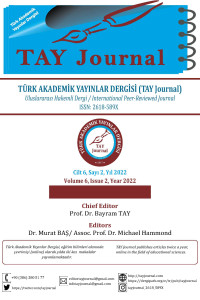Öz
Bu araştırmada, ortaokul 7. sınıf öğrencilerinin dijital güvenlik öz yeterlik düzeylerini belirlemek üzere bir “Dijital Güvenlik Öz Yeterlik Envanteri” geliştirmek amaçlanmıştır. Öncelikle Sosyal Bilgiler Öğretim Programı, Bilişim Teknolojileri ve Yazılım Dersi ve ilgili alanyazın taranarak 52 maddelik bir madde havuzu oluşturulmuştur. Uzman görüşleri neticesinde gerekli düzenlemeler yapılarak 7 madde çıkarılmış, beşli Likert tipinde 5 alt ölçekten oluşan 45 maddelik bir envanter geliştirilmiştir. Alt ölçekler sırasıyla; teknik, psikososyal, çevrim içi alışveriş, hak ve sorumluluk ve sağlık alt ölçeğidir. Ölçeğin geçerlik ve güvenirlik çalışmaları için açımlayıcı faktör analizi (AFA) ve doğrulayıcı faktör analizi (DFA) yapılmış ve bu çalışmalar için toplamda 1174 ortaokul 7. sınıf öğrencisinden veri toplanmıştır. AFA sonucunda teknik alt ölçeğinden 5 madde çıkarılarak toplam varyansın %32,86’sını açıklayan 15 madde ve 2 faktörden oluşan bir yapı ortaya konulmuştur. Psikososyal alt ölçeğinde toplam varyansın %40,33’ünü açıklayan 8 maddelik tek faktörlü bir yapı, çevrim içi alışveriş alt ölçeğinde toplam varyansın %49,79’unu açıklayan 5 maddelik tek faktörlü bir yapı, hak ve sorumluluk alt ölçeğinde toplam varyansın %44,32’sini açıklayan 7 maddelik tek faktörlü bir yapı ve sağlık alt ölçeğinde toplam varyansın %49,81’ini açıklayan 5 maddelik tek faktörlü bir yapı ortaya konulmuştur. DFA sonucunda alt ölçeklere ilişkin elde edilen model uyum indeksleri kabul edilebilir düzeyde olup yapı kuramsal ve istatistiksel açıdan doğrulanmıştır. Güvenirlik çalışmaları sonucunda Cronbach Alfa güvenirlik katsayıları teknik alt ölçekte 0,85, psikososyal alt ölçekte 0,77, çevrim içi alışveriş alt ölçeğinde 0,78, hak ve sorumluluk alt ölçeğinde 0,78, sağlık alt ölçeğinde 0,75 olarak hesaplanmıştır. Yapılan analizlerin sonuçlarına göre ortaokul 7.sınıf öğrencileri için geliştirilmiş olan 40 maddelik ve 5 alt ölçekten oluşan dijital güvenlik öz yeterlik envanterinin geçerli ve güvenilir bir ölçme aracı olduğu kanıtlanmıştır.
Anahtar Kelimeler
dijital güvenlik öz yeterlik dijital güvenlik öz yeterliği scale development.
Kaynakça
- Akgün, Ö. & Topal, M. (2015). Eğitim fakültesi son sınıf öğrencilerinin bilişim güvenliği farkındalıkları: sakarya üniversitesi eğitim fakültesi örneği. Sakarya University Journal of Education, (5)2, 98-121.
- Livingstone, S., Mascheroni, G. & Staksrud, E. (2018). European research on children’s internet use: Assessing the past and anticipating the future. New Media & Society, 20(3), 1103–1122. https://doi.org/10.1177/1461444816685930
Öz
In this research, it was aimed to develop a “Digital Security Self-Efficacy Inventory” consisting of subscales to determine the digital security self-efficacy levels of secondary school seventh grade students. First of all, the Social Studies Course curriculum, Information Technologies and Software Course curriculum and related field literature were scanned and the topics of the 5 sub-scales were determined and article pools were created. The substance pools prepared in five likert types were presented to the expert opinion and the necessary arrangements were made. Exploratory Factor Analysis (EFA) and Confirmatory Factor Analysis (CFA) were performed for the validity and reliability studies of the five subscales included in the inventory. A total of 1174 secondary school seventh grade students made up the study group. As a result of the EFA, 5 items were removed from the technical subscale, and the total explained variance of the two-factor structure consisting of 15 items is 32.86%. Psychosocial sub-40,33 percent of the total variance in the scale that explains the 8-point one-factor structure, online shopping sub-5 percent of the total variance in the scale that explains 49,79-item, single-factor structure, rights and responsibilities of the sub-44,32 percent of the total variance in the scale that explains a 7-point single-factor structure and health sub-scale of the total variance in 49,81 5%, which explained the single-point-Factor Structure demonstrated. The structure is confirmed by looking at the model fit indices of the subscales in the CFA. In order to test the reliability, Cronbach Alpha reliability coefficients were examined and calculated as 0.85 on the technical sub-scale, 0.77 on the psychosocial sub-scale, 0.78 on the online shopping sub-scale, 0.78 on the rights and responsibilities sub-scale, and 0.75 on the health sub-scale. According to the results of the analyzes carried out, it has been proven that the sub-scales included in the Digital Security Self-Efficacy Inventory are a valid and reliable measurement tool.
Anahtar Kelimeler
digital security self-efficacy digital security self-efficacy scale development.
Kaynakça
- Akgün, Ö. & Topal, M. (2015). Eğitim fakültesi son sınıf öğrencilerinin bilişim güvenliği farkındalıkları: sakarya üniversitesi eğitim fakültesi örneği. Sakarya University Journal of Education, (5)2, 98-121.
- Livingstone, S., Mascheroni, G. & Staksrud, E. (2018). European research on children’s internet use: Assessing the past and anticipating the future. New Media & Society, 20(3), 1103–1122. https://doi.org/10.1177/1461444816685930
Ayrıntılar
| Birincil Dil | İngilizce |
|---|---|
| Konular | Alan Eğitimleri |
| Bölüm | Araştırma Makaleleri |
| Yazarlar | |
| Erken Görünüm Tarihi | 26 Ekim 2022 |
| Yayımlanma Tarihi | 31 Aralık 2022 |
| Yayımlandığı Sayı | Yıl 2022 Cilt: 6 Sayı: 2 |


